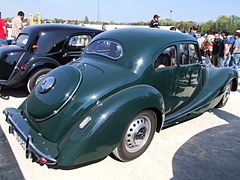
The straight-six engine is an internal combustion engine, with six cylinders mounted in a straight line along the crankcase with all the pistons driving a common crankshaft.

The Jaguar XK is an inline 6-cylinder dual overhead camshaft (DOHC) engine produced by Jaguar Cars between 1949 and 1992. Introduced as a 3.4-litre, it earned fame on both the road and track, being produced in five displacements between 2.4 and 4.2-litres for Jaguar passenger cars, with other sizes being made by Jaguar and privateers for racing. A de-rated version was also used in certain military vehicles built by Alvis and Daimler.

In automotive engineering a multi-valve or multivalve engine is one where each cylinder has more than two valves. A multi-valve engine has better breathing and may be able to operate at higher revolutions per minute (RPM) than a two-valve engine, delivering more power.

The Triumph Vitesse is a compact six-cylinder car built by Standard-Triumph from May 1962 to July 1971. The car was styled by Giovanni Michelotti, and was available in saloon and convertible variants.

The Lancia Aurelia is a car produced by Italian manufacturer Lancia from 1950 to the summer of 1958. It is noted for using one of the first series-production V6 engines. Several body styles were offered: 4-door saloon, 2-door GT coupé (B20), 2-door spider/convertible (B24), and a chassis to be custom bodied by external coachbuilders.

The Rover P4 series is a group of mid-size luxury saloon cars produced by the Rover Company from 1949 until 1964. They were designed by Gordon Bashford.

The Audi S6 is the high performance variant of the Audi A6, an executive car produced by German automaker Audi. It went on sale in 1994, shortly after the "A6" designation was introduced, replacing the "100" nameplate.

The Aceca is a closed coupé from the British AC Cars company, produced from 1954 until 1963. The car originally had an AC engine but the similar Bristol-engined Aceca-Bristol was also available alongside the original from 1956 to 1963 when production of that engine ceased. A few cars were built from 1961 to 1963 with a 2553 cc tuned Ford Zephyr engine and sold as the Aceca 2.6.

The Alfa Romeo Twin Cam engine is an all-alloy inline-four engine series produced by Alfa Romeo from 1954 to 1994. In Italian it is known as the "bialbero" ("twin-shaft"), and has also been nicknamed the "Nord" (North) engine in reference to its being built in Arese, close to Milan, in the North of Italy and to distinguish it from the Alfa Romeo Boxer engine built in the South (Sud) for the Alfasud.

The Mitsubishi 4B1 engine is a range of all-alloy straight-4 piston engines built at Mitsubishi's Japanese "World Engine" powertrain plant in Shiga on the basis of the Global Engine Manufacturing Alliance (GEMA). Although the basic designs of the various engines are the same, their exact specifications are individually tailored for each partner. The cylinder block and other basic structural parts of the engine were jointly developed by the GEMA companies, but the intake and exhaust manifolds, the cylinder head's intake and exhaust ports, and other elements related to engine tuning were independently developed by Mitsubishi.
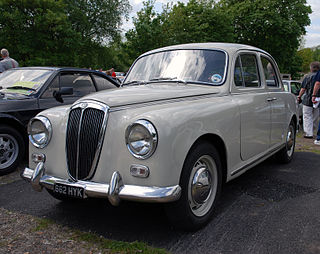
The Lancia Appia was a passenger car introduced in 1953 by Italian car manufacturer Lancia as a replacement for the Ardea, and which remained in production for ten years. The Appia was the last in a long line of Lancia production cars dating back to the Lancia Lambda to use the famous sliding pillar front suspension. All three series produced had a Lancia V4 engine of 1089 cc.
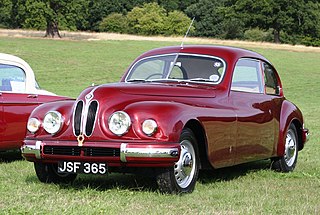
The Bristol 401 saloon and Bristol 402 cabriolet are British luxury sporting cars, produced between 1948 and 1953 by Bristol Cars, an offshoot of the Bristol Aeroplane Co.. They were developed from the Bristol 400, which continued in production alongside the 401 and 402 until 1950.
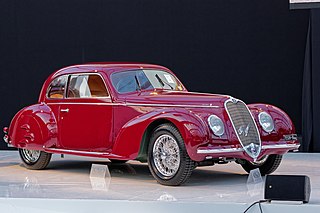
The Alfa Romeo 6C name was used on road, race, and sports cars produced between 1927 and 1954 by Alfa Romeo; the "6C" name refers to the six cylinders of the car's straight-six engine. Bodies for these cars were made by coachbuilders such as James Young, Zagato, Touring Superleggera, Castagna, and Pinin Farina. Beginning in 1933 there was also a 6C version with an Alfa factory body, built in Portello. In the early 1920s Vittorio Jano received a commission to create a lightweight, high performance vehicle to replace the Giuseppe Merosi designed RL and RM models. The car was introduced in April 1925 at the Salone dell' Automobile di Milano as the 6C 1500. It was based on the P2 racing car, using a single overhead cam 1,487 cc in-line six-cylinder engine, producing 44 horsepower. In 1928 the 1500 Sport was presented, which was the first Alfa Romeo road car with double overhead camshafts.

The BMW OHV V8 is an overhead valve V8 petrol engine produced from 1954 to 1965. It is BMW's first V8 engine, and BMW did not produce another V8 automobile engine until the BMW M60 in 1992.

The Bandini GT 750 is a road car produced in 1955 by Bandini Cars in their Forlì factory. It was the first two-seater to carry the Bandini badge. Although used for racing it was intended as a road car and used the chassis from the single seat 750 sport siluro with a tuned 747 cc 4-cylinder engine.
The Rover 16/50 and Rover 16 are mid-sized cars which were produced by Rover from 1926 to 1929 and non-continuously from 1936 to 1947 respectively.
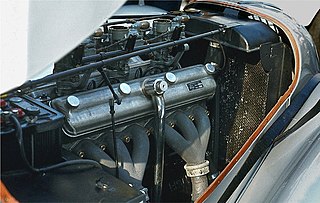
The BMW M328 is an overhead valve straight-six petrol engine which was produced from 1936 to 1940. It was a high-performance development of the BMW M78 engine that was produced alongside the M78.

The Mercedes-Benz OM629 is a 4.0 litres (3,996 cc) diesel-fuelled, 4-stroke, compression-ignition internal combustion 75° 32-valve V8 engine used in the 2000s. It is the world’s first aluminium V8 diesel engine.

